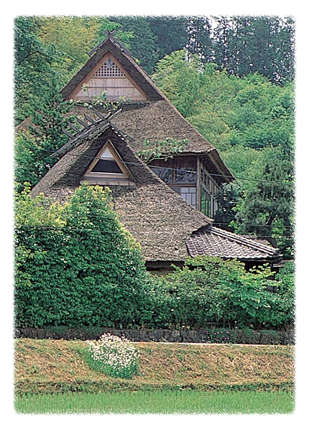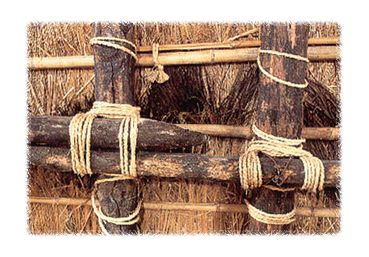
| There is nothing glamaorous
about the straw thatched house. Most of the fancy books depicting
the Japanese house, available in all languages, show and describe
beautiful buildings in exquisite details. These are buildings designed
by and for people who had the time and the money to spend on ever
more refined life styles and aesthetic pursuits, elaborate in their
simplicity. The Kayabuki house is a poor country cousin of these buildings, for poor farmers who spend their lives doing hard labor in the fields to supply food to the nobility and the city dwellers. Austerity is the main theme here... Yet, the basic ideas of Japanese living are all present in these homes, the immensely satisfying natural proportions of outlay and design, the place and function of kitchen, entrance hall and the living room, with a corner set aside for the display of beauty, like flower arrangements and objets d'art, even in the poorest parts of the country. |
 Seiler's Farm House, and (above) the Kayabuki Ongaku-do |
The straw roof covers one big living space. On one side, on ground level with dirt floors are kitchen and entrance hall. On the other side is the elevated straw mat living area, divided around a center beam into four rooms by sliding doors. These doors are made from paper, which is glued to a frame from both sides. Visual privacy is thus assured, yet there is an open space between all sliding doors and the ceiling. There are no keys or locks. Bath and outhouse are in a separate building. Interlocking beams make the main supporting structure, cross beams often are whole logs, Japanese pine with all their natural curves made to fit by skilled carpenters. Walls are made from wet clay mixed with chopped straw forced through a bamboo grill to dry on both sides. Logs leaning against and supporting each other are tied to the main frame to give the basic roof structure. Bamboo poles are tied across to support the 2 feet thick layers of straw tied onto them. Timber, bamboo, clay and straw, all building materials are taken from the immediate nature surroundings of the building site.
 |
There is not one nail in the house, everything is fitted together or tied together with straw ropes, making for a resilient and strong sutacture in hurricanes and earthquakes. Not meant and built to last for centuries, it may be allowed to desintegrate, all materials turning into earth again. |
Over the years we added and expanded living space to make room for two children and their friends visiting on weekends. We added a second building, an old Zen temple, to do concerts in, the Kayabuki Ongaku-do. It can seat an audience of 350 people. At rice planting time we have many of our helping friends stay overnight, we easily can accommodate and feed 10 to 20 people, even more. Sometimes when we go away for weeks, we let agreeable people rent the whole house and let them enjoy cool summer living in the very hot Japanese summers. You might want to stay for some time?
Get in touch by sending a postcard to...
603-8691 P.O.Box 24, Kyoto-shi, Kita Yubin Kyoku, Japan.
Kayabuki Ongaku-do Access Map>>>